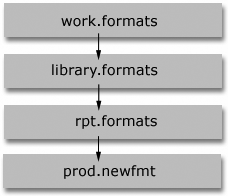Using Custom Formats
Overview
After
you have created a custom format, you can use SAS statements to permanently
assign the format to a variable in a DATA step, or you can temporarily
specify a format in a PROC step to determine how the data values appear
in output. You should already be familiar with referencing a format
in a FORMAT statement.
Another way to assign,
change, or remove the format that is associated with a variable in
an existing SAS data set is to use the DATASETS procedure to modify
the descriptor portion of a data set.
|
General form, DATASETS
procedure with the MODIFY and FORMAT statements:
PROC DATASETS LIB=SAS-library <NOLIST>;
MODIFY SAS-data-set;
FORMAT variable(s)
format;
QUIT;
SAS-library
is the name of the
SAS library that contains the data that you want to modify.
NOLIST
suppresses the directory
listing.
SAS-data-set
is the name of the
SAS data set you want to modify.
variable
is the name of one
or more variables whose format you want to assign, change, or remove.
format
is the name of a format
to apply to the variable or variables that are listed before it. If
you do not specify a format, any format that is associated with the
variable is removed.
|
Note: The
DATASETS procedure is interactive and remains in memory until you
issue the QUIT statement.
Using a Permanent Storage Location for Formats
When you permanently associate a format with a variable
in a data set, it is important to ensure that the format that you
are referencing is stored in a permanent location. Remember that the
storage location for the format is determined when the format is created
in the FORMAT procedure.
When you create formats
that you want to use in subsequent SAS sessions, it is useful to take
these steps:
You can store formats
in any catalog that you choose. However, you must identify the format
catalogs to SAS before you can access them. You learn about this in
a later topic.
When a format is referenced,
SAS automatically looks through the following libraries in this order:
-
Work.Formats
-
Library.Formats
The Library libref is recommended
for formats because it is automatically searched when a format is
referenced. If you store formats in libraries or catalogs other than
those in the default search path, you must use the FMTSEARCH= system
option to tell SAS where to find your formats.
|
General form, FMTSEARCH=
system option:
OPTIONS FMTSEARCH= (catalog-1
catalog-2...catalog-n);
catalog
is the name of one
or more catalogs to search. The value of catalog can
be either libref or libref.catalog.
If only the libref is given, SAS assumes that Formats is the catalog
name.
|
The Work.Formats catalog
is always searched first, and the Library.Formats catalog is searched
next, unless one or both catalogs appear in the FMTSEARCH= list.
Example
Suppose you have formats
that are stored in the Rpt library and in the Prod.Newfmt catalog.
The following OPTIONS statement tells SAS where to find your formats:
options fmtsearch=(rpt prod.newfmt);
Because no catalog is
specified with the Rpt libref, the default catalog name Formats is
assumed. This OPTIONS statement creates the following search order:
Because the Work and
Library librefs were not specified in the FMTSEARCH= option, they
are searched in default order.
Avoiding Format Errors
Consider what happens if you forget to specify a catalog
in the FMTSEARCH= option, misspell a format name, or make some other
mistake that causes SAS to fail to locate the format that you have
specified.
By default, the FMTERR
system option is in effect. If you use a format that SAS cannot load,
SAS issues an error message and stops processing the step. To prevent
this, you must change the system option FMTERR to NOFMTERR. When NOFMTERR
is in effect, SAS substitutes a default format for the missing format
and continues processing.
|
General form, FMTERR
system option:
OPTIONS FMTERR | NOFMTERR;
FMTERR
specifies that when
SAS cannot find a specified variable format, it generates an error
message and stops processing. Substitution of a default format does
not occur.
NOFMTERR
replaces missing formats
with the w. or $w.
default format and continues processing.
|
Example
Suppose the FMTERR system
option is in effect. In a previous example, we created the $ROUTES.
format to group airline routes into zones. In the following code,
the $ROUTES. format is misspelled:
proc print data=sasuser.cargorev(obs=10);
format route $route.;
run;Because
FMTERR is in effect, the format cannot be located and SAS stops processing
the step. An error message is written to the log.
30 proc print data=sasuser.cargorev(obs=10);
31 format route $route.;
ERROR: The format $ROUTE was not found or could not be loaded.
32 run;
NOTE: The SAS System stopped processing this step because of errors. |
If
the NOFMTERR system option is specified, substitution of a default
format occurs, and SAS continues to process the step.
options nofmterr;
proc print data=sasuser.cargorev(obs=10);
format Route $route.;
run;SAS substitutes the
$w. format for the $ROUTE. format that it could not locate. No message
is written to the log and processing continues. You can see from the
output that the format that you intended to use has not been applied.
..................Content has been hidden....................
You can't read the all page of ebook, please click here login for view all page.


